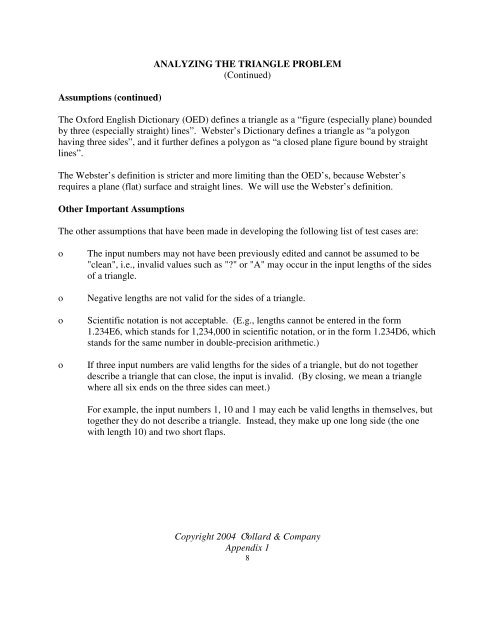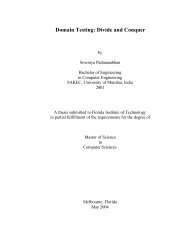appendix 1. analyzing the triangle problem - Testing Education
appendix 1. analyzing the triangle problem - Testing Education
appendix 1. analyzing the triangle problem - Testing Education
You also want an ePaper? Increase the reach of your titles
YUMPU automatically turns print PDFs into web optimized ePapers that Google loves.
Assumptions (continued)<br />
ANALYZING THE TRIANGLE PROBLEM<br />
(Continued)<br />
The Oxford English Dictionary (OED) defines a <strong>triangle</strong> as a “figure (especially plane) bounded<br />
by three (especially straight) lines”. Webster’s Dictionary defines a <strong>triangle</strong> as “a polygon<br />
having three sides”, and it fur<strong>the</strong>r defines a polygon as “a closed plane figure bound by straight<br />
lines”.<br />
The Webster’s definition is stricter and more limiting than <strong>the</strong> OED’s, because Webster’s<br />
requires a plane (flat) surface and straight lines. We will use <strong>the</strong> Webster’s definition.<br />
O<strong>the</strong>r Important Assumptions<br />
The o<strong>the</strong>r assumptions that have been made in developing <strong>the</strong> following list of test cases are:<br />
o The input numbers may not have been previously edited and cannot be assumed to be<br />
"clean", i.e., invalid values such as "?" or "A" may occur in <strong>the</strong> input lengths of <strong>the</strong> sides<br />
of a <strong>triangle</strong>.<br />
o Negative lengths are not valid for <strong>the</strong> sides of a <strong>triangle</strong>.<br />
o Scientific notation is not acceptable. (E.g., lengths cannot be entered in <strong>the</strong> form<br />
<strong>1.</strong>234E6, which stands for 1,234,000 in scientific notation, or in <strong>the</strong> form <strong>1.</strong>234D6, which<br />
stands for <strong>the</strong> same number in double-precision arithmetic.)<br />
o If three input numbers are valid lengths for <strong>the</strong> sides of a <strong>triangle</strong>, but do not toge<strong>the</strong>r<br />
describe a <strong>triangle</strong> that can close, <strong>the</strong> input is invalid. (By closing, we mean a <strong>triangle</strong><br />
where all six ends on <strong>the</strong> three sides can meet.)<br />
For example, <strong>the</strong> input numbers 1, 10 and 1 may each be valid lengths in <strong>the</strong>mselves, but<br />
toge<strong>the</strong>r <strong>the</strong>y do not describe a <strong>triangle</strong>. Instead, <strong>the</strong>y make up one long side (<strong>the</strong> one<br />
with length 10) and two short flaps.<br />
Copyright 2004 Collard 8 & Company<br />
Appendix 1<br />
8








